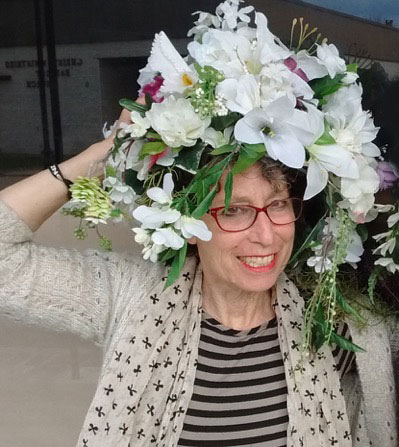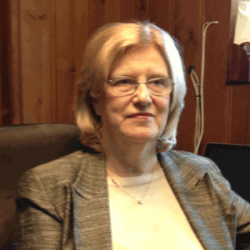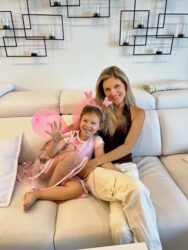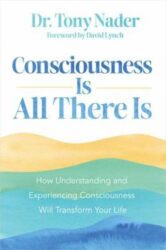From 12-Step to Transcendental Meditation: An Artist’s Journey of Healing from Domestic Violence

Dreamlike yet heartbreakingly real. Enigmatic yet compelling. Realistic yet abstract. Themes of circus performers, eagles, and horses. Splashes of joyful color mixed with menacing dark shadow.
All of these could be used to describe the work of the noted Hudson Valley painter and muralist Leslie Bender.
“I was always an artist and my mother was a package designer,” says Leslie, who at age 65 lives in a charming cottage in New Paltz, NY. “So I assumed I’d be an illustrator when I grew up. I was always drawing, always the best artist in the class. I continued to make art for the rest of my life because it was the only way I could express myself.”
Raised in New Jersey, Leslie graduated from the Pratt Institute of Brooklyn and from there she became a muralist with CityArts Workshop in Manhattan, completing giant public works with local communities. After receiving a diploma in Scenic Painting at Cobalt Studios, she painted theater sets as well as murals in private homes and other institutions. She currently teaches students privately and at Ulster County Community College while continuing to create her own art.
Although she has shown her paintings at such prestigious venues as the Whitney Museum of American Art and the Museum of Modern Art in New York City, what she considers her most memorable show in her 40-year career happened in Woodstock, NY, in 1990.
“I had left the city, moved to the mountains, dated a guy whose friends were connected with one of the old-time gallerists in New York,” she says. “When he came to town, my friend told him, ‘you should check out Leslie Bender’s work.’”
The gallerist ended up mounting a solo show for Leslie, and it was a massive success, cementing her reputation as a major Hudson Valley artist.
“That show broke all norms,” she says. “I like to say people were crying and buying.”
While the show included Leslie’s landscapes and circus scenes, it was the previously hidden works drawing from her history of childhood trauma and domestic violence that created a sensation.
“People related to my work because they were seeing the trauma of their own lives,” Leslie says. “They cried because someone was telling their story.”

Leslie recalls that during that time, journalists named her the “best artist in the Hudson Valley.” People would meet her and say, “Wow, you’re Leslie Bender?”
But beneath her success, there was a dark emptiness inside, an inability to cope with her abusive childhood.
“I was experiencing an enormous rage,” she says. “That affected my social relationships, which repeatedly broke down. The art was something that not only gave me pleasure, it was my way of expressing something that I couldn’t express in real life, because I was in denial. I was shut down.”
Leslie describes herself as a performer, like the jugglers and acrobats in her art. “People have their notions. Underneath I was this tortured wreck, but they didn’t see that.”
Searching for Answers
Eventually Leslie started on a spiritual odyssey to heal the wounds of her past. She moved to a local Gurdjieff community and also became a Sufi. (With her characteristic humor, she says, “I didn’t realize at first that these Sufis were orthodox Muslims—many of the people there were Jews like me!”)
After 12 years she abandoned the Gurdjieff practice, which, she says, required her to deny her emotions and had a destructive effect on her life and her art. She ended up rejecting both of these Gurdjieff and Sufism communities as “hierarchical,” which she defines as “people at the top reinterpreting the original teachings and creating a set of arbitrary rules and belief systems that others have to follow or else”—just as her abusive parents imposed on her.
Leslie describes her life in those years as a constant inner nightmare. “You live in a world where you project the violence on everything. You never see people for who they are and experience the love between people. You’re always living in a state of expectation of harm.”
While some interventions she tried, such as therapy and the 12-Step Program did have a good effect, she still couldn’t shake the shackles of her past. She says, “I did tons of work all those years. I tried everything. But I couldn’t crack the code, I just couldn’t.”
The Breakthrough
Today Leslie says she can talk about those dark years because for the first time, she’s breaking through the shell itself, thanks to practicing the Transcendental Meditation technique since 2015.
Like many people, her interest in TM began with a recommendation from a friend. “A friend who has bought my work over the years sent me some books by Maharishi, the founder of Transcendental Meditation, and said ‘you should really do this,’” she says.
About four months later she learned the TM technique through the David Lynch Foundation Women’s Health Initiative, which teaches TM to female survivors of domestic violence.
“I noticed right away that it was easy for me to do it faithfully,” she says. “And I didn’t think the panic attacks would ever go away—waking up in terror all the time. But with my daily TM, and the individual attention and supportive environment that Vanessa Vidal and Denise Gerace at Transcendental Meditation for Women* provided, the panic attacks have left me.”
Noting that her self-esteem has been given a huge boost, she says, “TM votes for you when you’re not voting for yourself. It means a lot to someone who’s been living this kind of trauma.”
She continues, “I feel splashes of happiness and there’s much more clarity. My friends say I’m happier. But I think getting in contact with a bigger Self that’s beneath these learned belief systems—that is the real breakthrough for me.”
Leslie explains that she appreciates TM because there is no hierarchy or belief system required. “You do not have to be ordered around. You basically are given a technique to follow your bliss. I say thank God for TM. I’m connecting to a Self, the eternal Self, that isn’t affected by these harmful beliefs that people teach you in order to control you.”
Cracking the Code
Like Leslie, thousands of women who have suffered the trauma of domestic violence and abuse have found welcome relief from deep-rooted stresses through the practice of TM. As she mentioned, the TM technique is not a religion, nor does it involve a particular belief system. It is a simple, mental technique, practiced at home, that allows the mind to go beyond thought, to reach a state of inner peace. At the same time, it allows the body to achieve a deep state of rest and let go of deep-rooted stresses. Scientific research on thousands of practitioners shows that acute anxiety, depression, PTSD, and emotional stress significantly subside with regular practice.
Women from around the world—from Africa to Asia to the Middle East to the US—are reporting that deep emotional scars can heal regular TM practice, allowing survivors of abuse to find happiness and peace again.
“It’s huge to be on my own team instead of being constantly afraid of other people and what they’re going to do,” says Leslie. “I’m cracking the code. It’s beautiful. I’m breaking through it.”
Leslie recounts her excitement when she recently found out that Bill Wilson—who co-founded AA and created the 12-Step Program that is now used widely for overcoming not only alcohol addiction but other challenges as well—practiced Transcendental Meditation.
“After he learned, he said he didn’t fully understand the 11th Step until he started TM,” says Leslie. “That blew me away. The 12-Step Program is beautifully in tandem with TM.”
Leslie is animated when she talks about the progress she’s made. “It’s important to me to talk about this,” she says. “I mean I did all the hard work for many years, so the breakthrough is just amazing.”
A Shift in Her Art
Despite years of searching for balance in her life, Leslie has never stopped making her beautiful art, producing thousands of paintings and mixed-media works and showing in prestigious galleries. As to be expected, now that she’s experiencing a huge inner shift, she’s finding that her art is changing dramatically too.
“When I first started out, I used to paint just to express this self,” she says. “But sooner or later you have to make a choice to come out of your isolation and to start to connect to others, and it did a number on my art. The struggle began—I was so caught in worrying about not being accepted by the contemporary world, that my work wouldn’t sell.”
But suddenly, last spring, she says she took the brave step of reclaiming her art for self-expression.
“At first I felt so alone—it was scary and awful,” she says. “But now my own work is starting to come back, like it was in the beginning. Only then I was motivated by rage, but now, with TM, it’s a pleasure to be able to consciously express my deep inner truth. There’s something about accepting myself that makes it easier to know what I want to put where.”
Another way that Leslie’s art is changing: she’s expressing more joy. Leslie points to a recent painting, “The Arrival of Sinterklaas,” on her website. “I have older versions of that, and there was this big hulking figure in the middle. It was dark, really grim. After starting TM and moving to a bright new loft studio in Kingston, I eliminated that dark figure.”
Today, Leslie says that it’s difficult for her to look back at the art that she did for the 1990 Woodstock show. “I am proud of all my work, but some of that is hard for me to re-enter, to feel the painful emotions,” she says. “It’s hard to even breathe in that suffocating environment. Now there’s a lot of light coming in.”
Leslie looks forward to even greater success as an artist as she comes out of her shell, and even greater inner growth.
“Everything I’ve been through has helped me to reclaim my past and live a life of vitality in the present,” she says. “I feel my true success is the indomitable spirit that never gave up and at age 65 is still blossoming.”
* The DLF Women’s Health Initiative is one of TM for Women’s partner programs. See more partner programs here.
Find Out More:
• Check out Leslie Bender’s website
• See more recent works
About the Author
Linda Egenes writes about green and healthy living and is the author of six books, including The Ramayana: A New Retelling of Valmiki’s Ancient Epic—Complete and Comprehensive, co-authored with Kumuda Reddy, M.D.
More Posts by Linda
- Tired and Burned Out? Transcendental Meditation Can Help: An Interview with Dr. Nancy Lonsdorf, MD
- Worried About the Future? Six Ways to Calm Your Anxiety
- What Do You Carry in Your Self-Care Tool Kit?
- Five Strategies for Family Caregivers
- From the Streets to College in Four Months: The Communiversity of South Africa Empowers Underserved Youth in Cape Town





